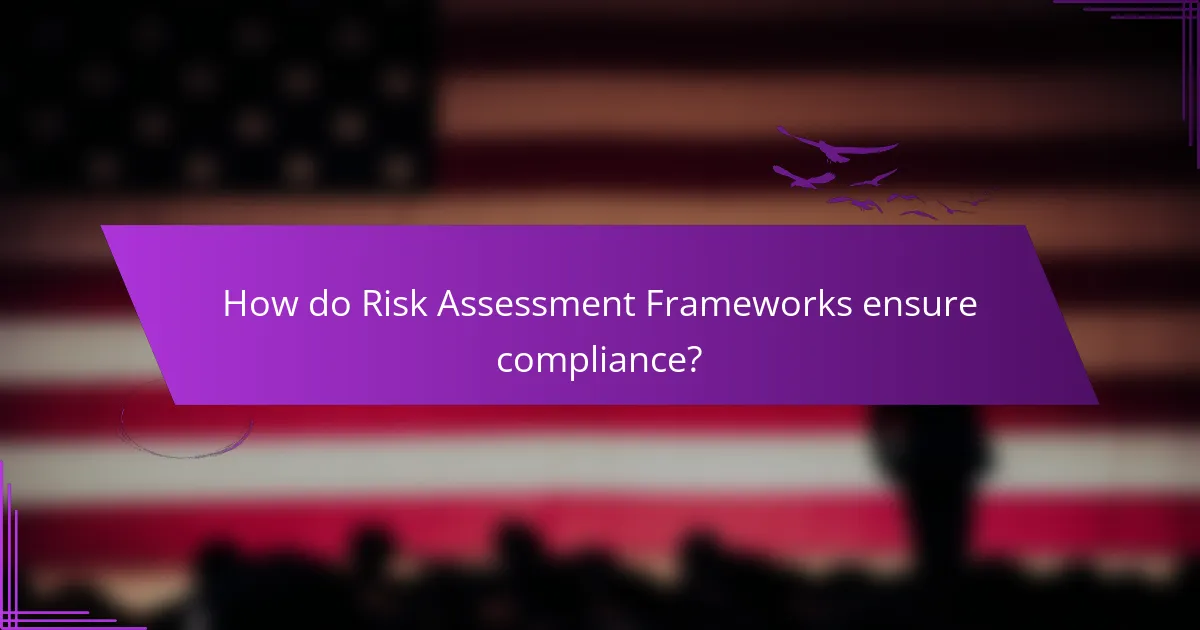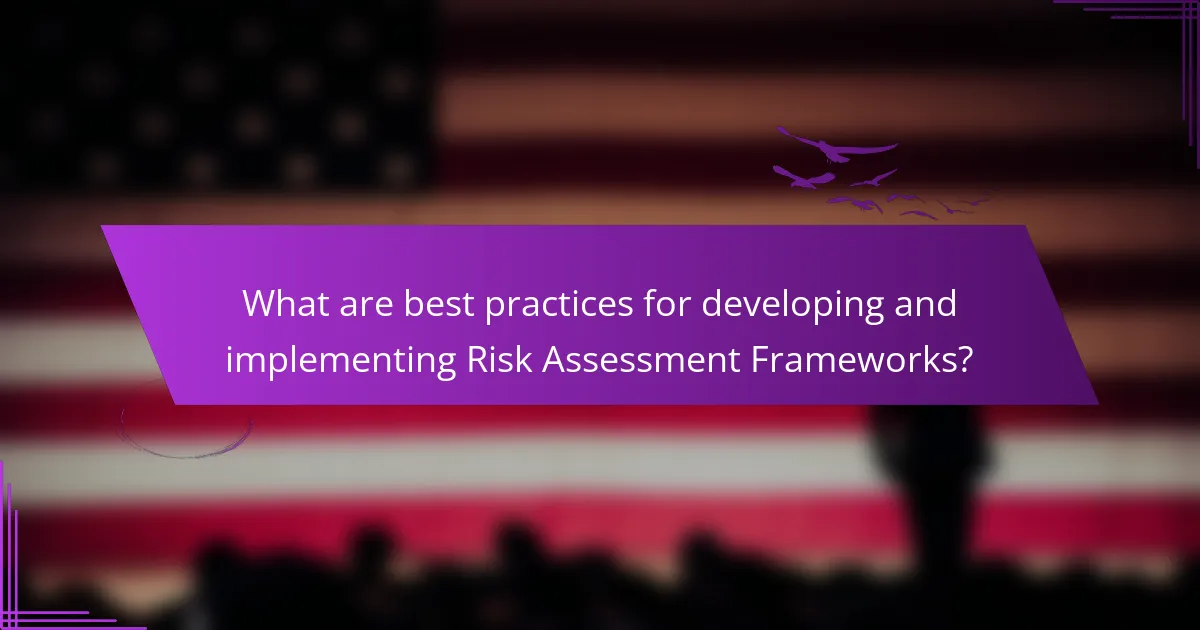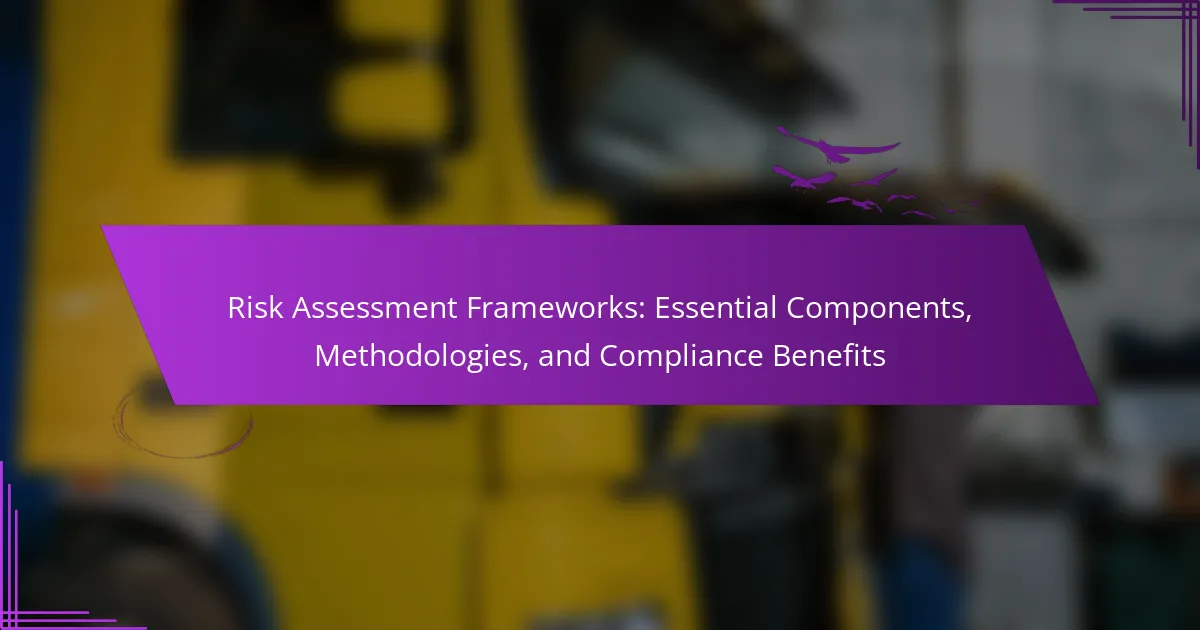
What are Risk Assessment Frameworks?
Risk assessment frameworks are structured approaches used to identify, evaluate, and prioritize risks. They provide organizations with methodologies to systematically analyze potential threats and vulnerabilities. Commonly used frameworks include NIST, ISO 31000, and FAIR. These frameworks enable organizations to make informed decisions regarding risk management. They often incorporate guidelines for risk mitigation strategies. Effective implementation can enhance compliance with regulatory requirements. Risk assessment frameworks also facilitate continuous monitoring and improvement of risk management processes.
Why are Risk Assessment Frameworks important for organizations?
Risk assessment frameworks are crucial for organizations because they provide structured methodologies to identify and evaluate risks. These frameworks help organizations prioritize risks based on their potential impact. By systematically assessing risks, organizations can implement effective mitigation strategies. This proactive approach reduces the likelihood of negative outcomes. Additionally, risk assessment frameworks ensure compliance with regulatory requirements. For example, frameworks like ISO 31000 guide organizations in establishing risk management processes. This adherence promotes stakeholder confidence and enhances decision-making. Ultimately, risk assessment frameworks contribute to organizational resilience and long-term sustainability.
What key elements define a Risk Assessment Framework?
A Risk Assessment Framework is defined by several key elements. These elements include risk identification, risk analysis, risk evaluation, risk treatment, and monitoring and review.
Risk identification involves recognizing potential risks that could impact objectives. This can be achieved through various methods such as brainstorming, checklists, or expert interviews.
Risk analysis assesses the likelihood and impact of identified risks. It helps prioritize risks based on their potential effect on the organization.
Risk evaluation compares the level of risk against risk criteria. This determines whether the risk is acceptable or requires treatment.
Risk treatment involves selecting and implementing measures to mitigate risks. Options include avoiding, reducing, transferring, or accepting risks.
Monitoring and review ensure the framework remains effective. This involves regularly checking the risk environment and updating the framework as necessary.
Each of these elements is essential for a comprehensive risk assessment process. They collectively ensure that organizations can effectively manage risks and protect their objectives.
How do Risk Assessment Frameworks contribute to decision-making?
Risk assessment frameworks enhance decision-making by providing structured methodologies for identifying, analyzing, and mitigating risks. These frameworks facilitate a systematic approach to evaluating potential threats and opportunities. By quantifying risks, they allow decision-makers to prioritize actions based on severity and likelihood. This prioritization helps allocate resources effectively, ensuring that critical risks are addressed first. Additionally, risk assessment frameworks promote transparency and accountability in the decision-making process. They enable stakeholders to understand the rationale behind decisions, fostering trust and collaboration. Empirical studies demonstrate that organizations using structured risk assessment frameworks experience improved outcomes and reduced incidents. For instance, a study by the Institute of Risk Management found that companies employing these frameworks reported a 30% decrease in risk-related losses.
What are the essential components of a Risk Assessment Framework?
The essential components of a Risk Assessment Framework include risk identification, risk analysis, risk evaluation, risk treatment, and monitoring and review. Risk identification involves recognizing potential risks that could affect objectives. Risk analysis assesses the likelihood and impact of identified risks. Risk evaluation compares risk levels against risk criteria to prioritize them. Risk treatment involves selecting and implementing measures to mitigate risks. Finally, monitoring and review ensure that the framework remains effective and relevant. These components work together to provide a systematic approach to managing risks, enhancing organizational resilience.
What types of risk identification methods are used?
Common types of risk identification methods include brainstorming, interviews, checklists, and SWOT analysis. Brainstorming involves gathering a group to generate ideas about potential risks. Interviews are conducted with stakeholders to uncover risks based on their experiences. Checklists provide a systematic way to identify risks by referencing known issues. SWOT analysis evaluates strengths, weaknesses, opportunities, and threats to identify risks in a structured manner. Each method offers unique insights and contributes to a comprehensive risk assessment.
How is risk analysis conducted within these frameworks?
Risk analysis within risk assessment frameworks is conducted through systematic evaluation processes. These processes typically involve identifying potential risks and assessing their likelihood and impact. Frameworks often utilize qualitative and quantitative methods for this assessment. Qualitative methods may include expert judgment and scenario analysis. Quantitative methods may involve statistical modeling and data analysis. The analysis results guide decision-making and risk management strategies. This structured approach ensures comprehensive risk evaluation. For example, the NIST Risk Management Framework emphasizes a continuous risk assessment cycle. This cycle includes preparation, assessment, response, and monitoring stages.
What methodologies are commonly used in Risk Assessment Frameworks?
Common methodologies used in Risk Assessment Frameworks include qualitative analysis, quantitative analysis, and hybrid approaches. Qualitative analysis assesses risks based on subjective judgment and expert opinion. It often uses tools like risk matrices to prioritize risks. Quantitative analysis relies on numerical data and statistical methods to evaluate risks. This approach provides measurable outcomes and can include techniques like Monte Carlo simulations. Hybrid approaches combine both qualitative and quantitative methods for a comprehensive assessment. These methodologies are widely recognized in standards such as ISO 31000, which outlines principles and guidelines for risk management.
What is the difference between qualitative and quantitative risk assessment methodologies?
Qualitative risk assessment methodologies focus on subjective evaluation of risks. They assess risks based on descriptive factors such as likelihood and impact. This approach often uses expert judgment and categorization. It provides insights into potential risks without numerical data.
Quantitative risk assessment methodologies rely on numerical data and statistical analysis. They quantify risks using measurable parameters and mathematical models. This method provides a more objective assessment of risks. It often results in specific numerical values for risk likelihood and impact.
The primary difference lies in their approach: qualitative is subjective and descriptive, while quantitative is objective and numerical. Each methodology serves different purposes in risk management.
How do specific methodologies enhance the effectiveness of risk assessments?
Specific methodologies enhance the effectiveness of risk assessments by providing structured approaches to identify and evaluate risks. These methodologies include qualitative, quantitative, and hybrid methods. Qualitative methods rely on expert judgment and experience to assess risks. Quantitative methods use statistical data to measure risk likelihood and impact.
The use of standardized frameworks, such as ISO 31000, ensures consistency in risk assessment processes. This consistency allows organizations to compare risks across different projects effectively. Additionally, methodologies like Failure Mode and Effects Analysis (FMEA) help prioritize risks based on their potential impact.
Evidence shows that organizations employing structured methodologies report improved decision-making. A study by the Project Management Institute found that projects using formal risk management practices are 20% more likely to succeed. This increase in success rates is attributed to better risk identification and mitigation strategies.
Overall, specific methodologies create a systematic approach, leading to more reliable and actionable risk assessments.

How do Risk Assessment Frameworks ensure compliance?
Risk Assessment Frameworks ensure compliance by systematically identifying and evaluating risks. They provide structured methodologies that organizations can follow to assess potential threats. This process includes analyzing regulatory requirements and aligning them with organizational practices. Frameworks like ISO 31000 and NIST RMF offer guidelines to meet compliance standards. They help organizations implement controls to mitigate identified risks. Regular audits and assessments within these frameworks ensure ongoing compliance. By documenting processes and outcomes, organizations can demonstrate adherence to legal and regulatory obligations. This structured approach ultimately reduces the likelihood of non-compliance penalties.
What regulations and standards influence Risk Assessment Frameworks?
Regulations and standards influencing Risk Assessment Frameworks include ISO 31000, NIST SP 800-30, and COSO ERM. ISO 31000 provides guidelines for risk management principles and framework. NIST SP 800-30 offers a structured approach for risk assessment in information systems. COSO ERM focuses on enterprise risk management and integrates risk assessment into organizational processes. These frameworks establish best practices and compliance requirements. They help organizations systematically identify, assess, and manage risks. Compliance with these standards enhances organizational resilience and governance.
How do Risk Assessment Frameworks align with industry compliance requirements?
Risk assessment frameworks align with industry compliance requirements by providing structured methodologies for identifying and managing risks. These frameworks help organizations adhere to regulations by ensuring systematic risk evaluation processes. For instance, frameworks like ISO 31000 and NIST SP 800-37 offer guidelines that meet specific compliance standards. They facilitate compliance by integrating risk management into organizational processes. This integration supports organizations in demonstrating due diligence and accountability. Additionally, risk assessment frameworks often include documentation and reporting standards that fulfill regulatory obligations. By aligning risk management practices with compliance requirements, organizations can mitigate potential legal and financial repercussions.
What role do Risk Assessment Frameworks play in audits and assessments?
Risk Assessment Frameworks provide structured methodologies for identifying and evaluating risks in audits and assessments. They help organizations systematically analyze potential threats and vulnerabilities. This structured approach enhances decision-making and prioritizes risk management efforts. Frameworks such as NIST, ISO, and COSO guide the assessment process effectively. They ensure compliance with regulatory requirements and industry standards. By utilizing these frameworks, organizations can improve their risk mitigation strategies. They also facilitate better communication among stakeholders regarding risk management. Overall, Risk Assessment Frameworks play a crucial role in enhancing the effectiveness of audits and assessments.
What are the compliance benefits of implementing Risk Assessment Frameworks?
Implementing Risk Assessment Frameworks enhances compliance by systematically identifying and mitigating risks. These frameworks help organizations adhere to regulatory requirements. They provide structured methodologies for assessing potential threats. This leads to improved risk management and decision-making processes. Organizations can demonstrate their commitment to compliance through documented risk assessments. Regular assessments ensure ongoing compliance with evolving regulations. Additionally, these frameworks facilitate better communication of risks to stakeholders. Ultimately, they help avoid legal penalties and enhance organizational reputation.
How do these frameworks mitigate legal and financial risks?
Risk assessment frameworks mitigate legal and financial risks by providing structured methodologies for identifying and managing potential threats. These frameworks establish clear guidelines for compliance with relevant laws and regulations. They enhance decision-making by offering data-driven insights into risk exposure. By implementing these frameworks, organizations can proactively address vulnerabilities before they escalate into legal issues or financial losses. For instance, frameworks like ISO 31000 promote a culture of risk awareness, which reduces the likelihood of regulatory penalties. Additionally, adherence to these frameworks can lower insurance premiums by demonstrating effective risk management practices. This systematic approach ensures that organizations remain resilient against unforeseen challenges.
What impact do Risk Assessment Frameworks have on organizational reputation?
Risk Assessment Frameworks significantly enhance organizational reputation. They provide structured methodologies for identifying and mitigating risks. This proactive approach builds trust among stakeholders. Organizations that implement these frameworks demonstrate commitment to safety and compliance. Research shows that companies with robust risk management practices are viewed more favorably. For instance, a study by the Institute of Risk Management found that effective risk management correlates with higher stakeholder confidence. Additionally, organizations that prioritize risk assessment often experience fewer crises, further solidifying their reputation. Overall, these frameworks contribute to a positive public image and stakeholder loyalty.

What are best practices for developing and implementing Risk Assessment Frameworks?
Best practices for developing and implementing Risk Assessment Frameworks include establishing a clear scope and objectives. This ensures that the framework aligns with organizational goals. Engaging stakeholders is crucial for gathering diverse perspectives and insights. Conducting thorough risk identification is essential to uncover potential threats. Utilizing qualitative and quantitative analysis enhances the assessment’s accuracy. Documenting processes and findings promotes transparency and accountability. Regularly reviewing and updating the framework keeps it relevant to changing conditions. Training staff on the framework fosters a risk-aware culture within the organization. These practices increase the effectiveness of risk management efforts and support compliance with regulations.
How can organizations tailor Risk Assessment Frameworks to their specific needs?
Organizations can tailor Risk Assessment Frameworks to their specific needs by identifying key risks relevant to their operations. They should assess the unique characteristics of their industry and regulatory environment. Customization involves integrating organizational goals into the framework. This ensures that risk management aligns with strategic objectives. Organizations can also involve stakeholders to gather diverse perspectives on potential risks. Utilizing specific metrics and indicators can enhance the relevance of the framework. Regular reviews and updates are essential to adapt to changing circumstances. Tailored frameworks improve risk mitigation effectiveness and compliance with regulations.
What steps should be taken to ensure effective stakeholder engagement?
Identify stakeholders and their interests. This step involves mapping out all individuals or groups affected by the project. Understand their needs and expectations to tailor engagement strategies. Develop a communication plan that outlines how to share information with stakeholders. Regular updates foster transparency and trust. Schedule meetings to gather feedback and discuss concerns. This two-way communication strengthens relationships. Use surveys or questionnaires to assess stakeholder satisfaction. Analyze the data to improve engagement practices. Finally, review and adjust engagement strategies as needed. Continuous improvement ensures effective stakeholder involvement throughout the project lifecycle.
How can continuous improvement be integrated into Risk Assessment Frameworks?
Continuous improvement can be integrated into Risk Assessment Frameworks by establishing a systematic process for feedback and evaluation. This involves regularly reviewing risk assessments to identify areas for enhancement. Organizations should use performance metrics to measure the effectiveness of risk management strategies. Incorporating stakeholder feedback can also provide insights for improvement. Training and development programs can ensure that staff are equipped with the latest risk management practices. Regular audits can identify compliance gaps and areas for growth. Documenting lessons learned from past incidents can inform future risk assessments. This iterative approach fosters a culture of continuous improvement within the risk management process.
What common challenges do organizations face with Risk Assessment Frameworks?
Organizations commonly face challenges with Risk Assessment Frameworks, including lack of standardization, insufficient data, and inadequate training. The absence of standardization leads to inconsistent risk evaluation processes across departments. Insufficient data can hinder accurate risk identification and analysis, resulting in incomplete assessments. Inadequate training for staff may cause misinterpretation of risks and ineffective implementation of frameworks. Furthermore, organizations often struggle with integrating risk management into existing business processes. This integration is crucial for ensuring that risk assessments align with organizational goals. Additionally, evolving regulatory requirements can complicate compliance efforts. Adapting frameworks to meet these changing regulations requires ongoing effort and resources.
How can organizations overcome resistance to adopting Risk Assessment Frameworks?
Organizations can overcome resistance to adopting Risk Assessment Frameworks by fostering a culture of awareness and education. Training sessions can clarify the importance of risk assessment and its benefits. Engaging stakeholders early in the process builds buy-in and reduces skepticism. Demonstrating the framework’s effectiveness through case studies can provide tangible proof of value. Additionally, addressing concerns and feedback from employees helps tailor the framework to organizational needs. Highlighting compliance benefits can also motivate adoption. Ultimately, leadership support is crucial for driving acceptance and commitment to the framework.
What resources are available to assist in the implementation of these frameworks?
Resources available to assist in the implementation of risk assessment frameworks include guidelines, toolkits, and software solutions. Organizations can refer to the National Institute of Standards and Technology (NIST) Special Publication 800-37 for comprehensive guidelines. The ISO 31000 standard provides a framework for risk management principles. Additionally, various software tools like RiskWatch and RiskLens offer practical applications for assessing and managing risks. Training programs and workshops from professional organizations also support implementation efforts. These resources collectively enhance understanding and facilitate effective application of risk assessment frameworks.
Risk assessment frameworks are structured methodologies that organizations use to identify, evaluate, and prioritize risks, facilitating informed decision-making and compliance with regulatory requirements. The article outlines the essential components of these frameworks, including risk identification, analysis, evaluation, treatment, and monitoring. It discusses various methodologies such as qualitative and quantitative analysis, highlighting their roles in enhancing risk assessments. Additionally, the article addresses the compliance benefits of implementing these frameworks, emphasizing their importance in mitigating legal and financial risks while improving organizational reputation. Common challenges and strategies for effective stakeholder engagement and continuous improvement are also explored.
